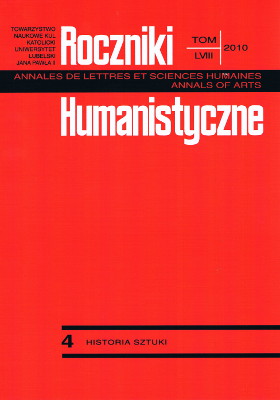The Head-Face Body Metaphors in Selected Paintinings by Duccio and Giotto
Abstract
The body and carnality in art, especially in the Middle Ages, have been researched widely over the past decade. The list includes, among others, such seminal works as those by V. Dasen, J. Wilgaux, N. Laneyrie-Dagen, G. Didi-Huberman, J. J. Courtine, C. Haroche. Also, the author of this paper has published on the topic. As a research problem, the body is not limited to the issue of nakedness. Neither is it reducible to the question of the general conception of painting the body – whether human or divine, and whether it matches the classical conception (that assumes some ideal reproduction of the body, in harmony with proportions and with the human nature) or not. Medieval art betrays deliberate deformations from the classical canon. Some of them have been named styles, when an artist was said to have purposefully transgressed the classical conception. Other distortions have been pronounced failures to properly artistically reconstruct the human body, due to the lack of proper education in Antique classical art.
The way in which the body is reconstructed artistically implies its role in the composition as a whole, including the relation between the painted figure to the other people presented in the painting (accompanying persons or random witnesses of a scene). It was the logic of the content that dictated the fashion in which divine and human figures were presented. This convention was also of use in presenting the head-face element as the most important body part. It was the head and the face where the content and the symbolic message, along with all body-related metaphors, were cumulated. The off-side figures and the passers-by were depicted in their individual, natural portrayals and were not bound by the artistic or dogmatic convention or message. These variations in the way in which the head-face element was artistically reconstructed in paintings are discussed and illustrated with the use of a selection of works by Duccio and Giotto.
References
Chastel A., II gesto nell arte, Ed. Liana Levi, „Economia laterza”, Roma-Bari 2002.
Courtine J.-J., Haroche C., Historia twarzy. Wyrażanie i ukrywanie emocji od XVI do początku XIX wieku, przekł. T. Swoboda, Gdańsk: Słowo/Obraz/Terytoria 2007.
Dalmasso V., L’image du corps dans la peinture toscane (v.1300-v.1450), Rennes: Presses Universitaires de Rennes 2006.
Didi-Huberma n G., L’image ouverte. Motifs de l’incamation dans les arts visuels, Paris: Ed. Gallimard 2007.
Didi-Huberma n G., Era Angelico. Dissemblance et Figuration, Paris: Flammarion 1990.
Dobrzeniecki T., Codex Aureus, Warszawa: PWN 1977.
Jurgis Baltrusaitis, Le Moyen Age fantastique. Antiquites et exotismes dans 1 art gotique, Paris: Armand Colin 1955.
Konik M., Harmonia natury ludzkiej. (Musica Humana) u Boecjusza, [w:] Homo Viator. Teksty i studia nad antropologią filozoficzną w średniowieczu, red. M. Karaś, Kraków 2009, s. 155-156.
Laneyrie-Dagen N., L'invention du corps. La representation de l’homme du Moyen Age a la fin du XIX siecle, Paris: Flammarion 2005.
Mazurczak U., Ciało i jego cień. Refleksje nad sposobami ukazywania ciała w malarstwie europejskim, „Ethos” 2008, nr 82-83, s. 128-146.
Mazurczak U., Dwie starożytne tradycje rozumienia ciała w sztuce średniowiecznej, |w:] Księga pamiątkowa ku czci Księdza Profesora Remigiusza Popowskiego SDB, „Roczniki Humanistyczne” 54-55(2006-2007), z. 3, s. 157-180.
Mazurczak U., Representation of the Human Body in Romanesque Italian Painting. Realism or Stylistic Ornamentation, [w:] Księga Pamiątkowa dla Księdza Profesora Stanisława Kobielusa, Warszawa 2010.
Platon, Timajos Kritias albo Atlantyk, tłum. P. Siwek, Warszawa 1986.
Raczyńska B., Filozoficzna teoria człowieka w głównych traktatach salernitańskich (AlTorismi cum Glosulis Ursonis Salernitani; Quaestiones Nicolai Peripatetici), „Acta Mediaevalia” 11(1997), s. 35.
Reale G., Corpo anima e salute. II concetto di uomo da Omnero a Platone, Milano: Cortina 2006.
Schefold K., Die Bildnisse der antiken Dichter Render und Denker, Basel 1943.
Schonborn Ch., A Sua immagine e somiglianza, Torino: ed. Parole e Silenzie 2007.
Tartuferi A., Giotto, Giunti, Prato: ed. Prato 2007.
Thomann J., Pietro d’Abano on Giotto, „Journal of the Warburg and Courtauld Institutes” 54(1994), s. 238-241.
Widomski J., Ontologia liczby. Wybrane zagadnienia z ontologii liczby w starożytności i w średniowieczu, przedm. W. Stróżewski, Kraków: Dialogikon 1996.
Witruwiusz, O architekturze Ksiąg Dziesięć, z tekstu łacińskiego przeł. K. Kumaniecki, Warszawa: PWN 1956.
Wood I. N., Categorising the cynocephali, [w:] Ego Trouble. Authors and Their Identtities in the Early Middle Ages, hrsg. R. Corradini, M. Gillis, Wien 2010, s. 125-136.
De Vogel C., Ripensando Platone e il Platonismo, Milano: Vita e Pensiero 1990.
Copyright (c) 2010 Roczniki Humanistyczne

This work is licensed under a Creative Commons Attribution-NonCommercial-NoDerivatives 4.0 International License.





